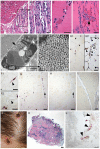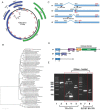Identification of a novel polyomavirus in a pancreatic transplant recipient with retinal blindness and vasculitic myopathy
- PMID: 24795478
- PMCID: PMC4334791
- DOI: 10.1093/infdis/jiu250
Identification of a novel polyomavirus in a pancreatic transplant recipient with retinal blindness and vasculitic myopathy
Abstract
Background: A 33 year-old pancreatic transplant recipient developed weakness, retinal blindness, and necrotic plaques on her face, scalp, and hands.
Methods: A muscle biopsy was analyzed by light and electron microscopy and high-throughput nucleic acid sequencing.
Results: The biopsy revealed microthrombosis and viral particles in swollen endothelial cell nuclei. High-throughput sequencing of nucleic acid revealed a novel polyomavirus. In situ hybridization confirmed the presence of the polyomavirus in endothelial cells at sites of myositis and cutaneous necrosis.
Conclusions: New Jersey polyomavirus (NJPyV-2013) is a novel polyomavirus that may have tropism for vascular endothelial cells.
Keywords: immunosuppression; myositis; polyomavirus; transplantation; vasculitis; virus discovery.
© The Author 2014. Published by Oxford University Press on behalf of the Infectious Diseases Society of America. All rights reserved. For Permissions, please e-mail: journals.permissions@oup.com.
Figures


Similar articles
-
Structural Basis and Evolution of Glycan Receptor Specificities within the Polyomavirus Family.mBio. 2020 Jul 28;11(4):e00745-20. doi: 10.1128/mBio.00745-20. mBio. 2020. PMID: 32723915 Free PMC article.
-
Human Polyomavirus 9-An Emerging Cutaneous and Pulmonary Pathogen in Solid Organ Transplant Recipients.JAMA Dermatol. 2022 Mar 1;158(3):293-298. doi: 10.1001/jamadermatol.2021.5853. JAMA Dermatol. 2022. PMID: 35138364 Free PMC article.
-
Genotypic diversity of polyomaviruses circulating among kidney transplant recipients in Kuwait.J Med Virol. 2013 Sep;85(9):1624-31. doi: 10.1002/jmv.23639. Epub 2013 Jun 17. J Med Virol. 2013. PMID: 23775307
-
Polyomavirus-induced interstitial nephritis in two renal transplant recipients: case reports and review of the literature.Am J Kidney Dis. 1997 May;29(5):754-8. Am J Kidney Dis. 1997. PMID: 9159311 Review.
-
Genome analysis of the new human polyomaviruses.Rev Med Virol. 2012 Nov;22(6):354-77. doi: 10.1002/rmv.1711. Epub 2012 Mar 28. Rev Med Virol. 2012. PMID: 22461085 Review.
Cited by
-
A new polyomavirus-related dermatosis in a pancreatic transplant patient.JAAD Case Rep. 2015 Nov 24;1(6):S38-40. doi: 10.1016/j.jdcr.2015.09.018. eCollection 2015 Nov. JAAD Case Rep. 2015. PMID: 27051808 Free PMC article. No abstract available.
-
Detection of Quebec Polyomavirus DNA in Samples from Different Patient Groups.Microorganisms. 2021 May 18;9(5):1082. doi: 10.3390/microorganisms9051082. Microorganisms. 2021. PMID: 34070030 Free PMC article.
-
Seroprevalence of fourteen human polyomaviruses determined in blood donors.PLoS One. 2018 Oct 23;13(10):e0206273. doi: 10.1371/journal.pone.0206273. eCollection 2018. PLoS One. 2018. PMID: 30352098 Free PMC article.
-
What is for dinner? Viral metagenomics of US store bought beef, pork, and chicken.Virology. 2014 Nov;468-470:303-310. doi: 10.1016/j.virol.2014.08.025. Epub 2014 Sep 16. Virology. 2014. PMID: 25217712 Free PMC article.
-
Polyomaviruses and disease: is there more to know than viremia and viruria?Curr Opin Organ Transplant. 2015 Jun;20(3):348-58. doi: 10.1097/MOT.0000000000000192. Curr Opin Organ Transplant. 2015. PMID: 25933251 Free PMC article. Review.
References
-
- Trowbridge PW, Frisque RJ. Identification of three new JC virus proteins generated by alternative splicing of the early viral mRNA. J Neurovirol. 1995;1:195–206. - PubMed
-
- Pinto M, Dobson S. BK and JC virus: a review. J Infect. 2014;68 (suppl 1):S2–8. - PubMed
-
- Petrogiannis-Haliotis T, Sakoulas G, Kirby J, et al. BK-related polyomavirus vasculopathy in a renal-transplant recipient. N Engl J Med. 2001;345:1250–5. - PubMed
Publication types
MeSH terms
Substances
Associated data
- Actions
Grants and funding
LinkOut - more resources
Full Text Sources
Other Literature Sources
Medical

